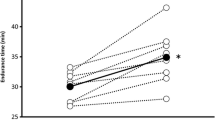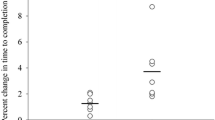Abstract
Healthy male endurance-trained cyclists [n = 11, age = 27.3 (3.9) years; mass = 73.0 (9.3) kg; height = 180.5 (6.9) cm; maximal oxygen consumption (\(\dot VO_{2max} \) = 71.1 (5.8) ml · kg−1 · min−1, mean ± (SD)] were recruited to assess the relationship between test protocol and the development of desaturation of arterial hemoglobin with oxygen, during incremental exercise tests to maximal aerobic capacity\((\dot VO_{2max} )\). All subjects demonstrated resting pulmonary function within normal limits [forced vital capacity (FVC) = 6.0 (0.9); forced expiratory volume (FEV1.0) = 4.9 (0.6); FEV1.0/FVC = 0.8 (0.1)] and completed three ramped\(\dot VO_{2max} \) tests (Mijnhardt KEM-3 electronically braked cycle ergometer) beginning at 0 W with increments of either 20, 30 or 40 W · min−1. All periods of testing were separated by a minimum of 72 h.\(\dot VO_{2max} \), peak minute ventilation\((\dot V_{Epeak} )\) (Medical Graphics, CPX-D), peak heart rate (ƒcpeak)), peak power output\((\dot W_{peak} )\), and minimum percentage arterial oxyhemoglobin saturation (%S aO2min) (Omeda Biox 3740 pulse oximeter) were determined. There were no significant differences (p > 0.05) in\((\dot W_{peak} )\) [191.5 (26.2), 196.0 (24.4), 194.3 (23.9) 1 · min−1] ƒcpeak [191.4 (7.0), 190.3 (5.5), 187.8 (5.9) beats · min−1],\(\dot VO_{2max} \) [5.0 (0.5), 5.1 (0.4), 5.1 (0.5) 1 · min−1] or %S aO2min [89.5 (1.5), 89.6 (1.3), 90.0 (2.3)] between protocols. The 20-W protocol [417 (27) W] demonstrated significantly lower\(\dot W_{peak} \) (P < 0.05) than the 30-W [434 (36) W] and 40-W [453 (38) W] protocols, indicating that peripheral fatigue may play an important factor in response to these tests. The results of this study demonstrate that arterial desaturation occurs as a result of intense exercise in highly trained athletes independent of the rate of attainment of\(\dot VO_{2max} \).
Similar content being viewed by others
References
Boutellier U, Buchel R, Kundert A, Spengler C (1992) The respiratory system as an exercise limiting factor in normal trained subjects. Eur J Appl Physiol 65:347–353.
Buchfuhrer MJ, Hansen JE, Robinson TE, Sue DY, Wasserman K, Whipp BJ (1983) Optimizing the exercise protocol for cardiopulmonary assessment. J Appl Physiol 55:1558–1564
Davis JA, Whipp BJ, Lamarra N, Huntsman DJ, Frank MH, Wasserman K (1982) Effect of ramp slope on determination of aerobic parameters from the ramp exercise test. Med Sci Sports Exerc 14:339–343
Dempsey JA, Hanson PG, Henderson KS (1984) Exercise-induced arterial hypoxaemia in healthy human subjects at sea level. J Physiol (Lond) 355:161–175
Ekblom B, Huot R, Stein E, Thorstensson AT (1975) Effect of changes in arterial oxygen content on circulation and physical performance. J Appl Physiol 39:71–75
Fairshter RD, Walters J, Salness K, Fox M, Minh V, Wilson AF (1983) A comparison of incremental exercise tests during cycle and treadmill ergometry. Med Sci Sports Exerc 15:549–554
Gale GE, Torre-Bueno JR, Moon RE, Saltzman HA, Wagner PD (1985) Ventilation-perfusion inequality in normal humans during exercise at sea level and simulated altitude. J Appl Physiol 58:978–988
Hammond MD, Gale GE, Kapitan KS, Ries A, Wagner PD (1986) Pulmonary gas exchange in humans during exercise at sea level. J Appl Physiol 60:1590–1598
Hansen JE, Casaburi R (1987) Validity of ear oximetry in clinical exercise testing. Chest 91:333–337
Hansen JE, Casaburi R, Cooper DM, Wasserman K (1988) Oxygen uptake as related to work rate increment during cycle ergometer exercise. Eur J Appl Physiol 57:140–145
Hopkins SR, McKenzie DC (1989) Hypoxic ventilatory response and arterial desaturation during heavy work. J Appl Physiol 67:1119–1124
Hopkins SR, McKenzie DC, Schoene RB, Glenny RW, Robertson HT (1994) Pulmonary gas exchange during exercise in athletes. 1. Ventilation-perfusion mismatch and diffusion limitation. J Appl Physiol 77:912–917
Koskolou MD, McKenzie DC (1994) Arterial hypoxemia and performance during intense exercise. Eur J Appl Physiol 68:80–86
Manier G, Moinard J, Techoueyres P, Varene N, Guenard H (1991) Pulmonary diffusion limitation after prolonged strenuous exercise. Respir Physiol 83:143–154
Manier G, Moinard J, Stoicheff H (1993) Pulmonary diffusing capacity after maximal exercise. J Appl Physiol 75:2580–2585
Martin D, Powers S, Cicale M, Collop N, Huang D, Criswell D (1992a) Validity of pulse oximetry during exercise in elite endurance athletes. J Appl Physiol 72:455–458
Martin D, Cicale M, Huang D, Menglecoch L, Powers S, Criswell D (1992b) Incidence of exercise-induced hypoxemia in male endurance athletes (abstract). Med Sci Sports Exerc 24:569
Miles DS, Doerr CE, Schonfeld SA, Sinks DE, Gotshall RW (1983) Changes in pulmonary diffusing capacity and closing volume after running a marathon. Respir Physiol 52:349–359
O'Kroy JA, Loy RA, Coast JR (1992) Pulmonary function changes following exercise. Med Sci Sports Exerc 24:1359–1364
Pedersen PK, Madsen K, Andersen C, Secher NH, Jensen K (1992) Arterial oxygen desaturation during dynamic exercise (abstract). Med Sci Sports Exerc 24:S69
Powers SK, Dodd S, Woodyard J, Beadle RE, Church G (1984) Hemoglobin saturation during incremental arm and leg exercise. Br J Sports Med 18(3):212–216
Powers SK, Dodd S, Lawler J, Landry G, Kirtley M, McKnight T, Grinton S (1988) Incidence of exercise induced hypoxemia in elite endurance athletes at sea level. Eur J Appl Physiol 58:298–302
Powers SK, Lawler J, Dempsey JA, Dodd S, Landry G (1989) Effects of incomplete pulmonary gas exchange on\(\dot VO_{2max} \). J Appl Physiol 66:2491–2495
Powers SK, Martin D, Cicale M, Collop M, Huang D, Criswell D (1992) Exercise-induced hypoxemia in athletes: role of inadequate hyperventilation. Eur J Appl Physiol 65:37–42
Rowell LB, Taylor HL, Wang Y, Carlson WS (1964) Saturation of arterial blood with oxygen during maximal exercise. J Appl Physiol 19:284–286
Schaffartzik W, Poole DC, Derion T, Tsukimoto K, Hogan MC, Arcos JP, Debout DE, Wagner PD (1992)V A/Q distribution during heavy exercise and recovery in humans: implications for pulmonary edema. J Appl Physiol 72:1657–1667
Schaffartzik W, Arcos J, Tsukimoto K, Mathieu-Costello O, Wagner PD (1993) Pulmonary interstitial edema in the pig after exercise. J Appl Physiol 75:2535–2540
Terrados N, Mizuno M, Andersen H (1985) Reduction in maximal oxygen uptake at low altitudes; role of training status and lung function. Clin Physiol Suppl 5:75–79
Wagner PD (1992) Ventilation-perfusion matching during exercise. Chest 101 [Suppl 5]:192S-198S
Wagner PD, Gale GE, Moon RE, Torre-Bueno JR, Stolp BW, Sattzman HA (1986) Pulmonary gas exchange in humans exercising at sea level and simulated altitude. J Appl Physiol 61:260–270
Williams JH, Powers SK, Stuart MK (1986) Hemoglobin desaturation in highly trained athletes during heavy exercise. Med Sci Sports Exerc 18:168–173
Younes M, Burks J (1985) Breathing pattern during and after exercise of different intensities. J Appl Physiol 59:898–908
Author information
Authors and Affiliations
Rights and permissions
About this article
Cite this article
Lama, I.L., Wolski, L.A., Coutts, K.D. et al. The relationship between test protocol and the development of exercise-induced hypoxemia (EIH) in highly trained athletes. Europ. J. Appl. Physiol. 74, 330–335 (1996). https://doi.org/10.1007/BF02226929
Accepted:
Issue Date:
DOI: https://doi.org/10.1007/BF02226929




